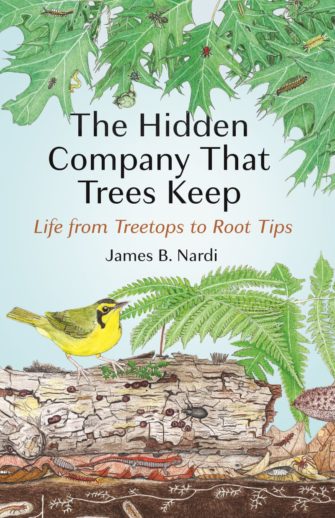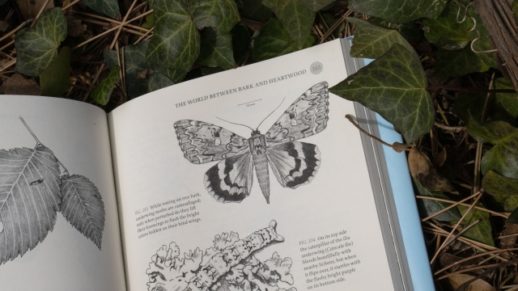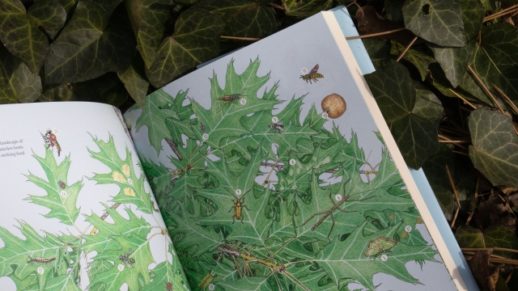 THE HIDDEN COMPANY THAT TREES KEEP
THE HIDDEN COMPANY THAT TREES KEEP
Life from Treetops to Root Tips
by James B. Nardi
Princeton University Press
ISBN 9780691237978
Published 21/3/23
Written by an academic expert, this book gives a detailed account of a tree’s many companions, from mammals to invertebrates and micro-organisms. The author, James B. Nardi, is an entomologist at the University of Illinois with previous publications aimed at amateur naturalists. It is presented as a popular science book, but having read the book the target audience is not obvious. The main body is a compendium of groups of species, arranged by the parts of the tree that they inhabit: different chapters deal with leaves, buds and twigs; the tree’s circulatory system; the world between bark and heartwood; flowers and fruits; and the world beneath the tree. Most of the described species are invertebrates, many of which will only be familiar to other specialists, and some of the language is quite technical.
For each group of animals, detailed information is provided including the number of known species, their size distribution, and the morphology, life-cycle, feeding habits, parasites, etc. of selected examples. It can feel a little dry and repetitive, and is likely to be of most interest to students of ecology and entomology. However, the text includes so many surprising facts about the lives of these hidden creatures that, despite skimming over some of the detail, I found it quite fascinating (see below). Some help is given to the non-specialist, such as translations of scientific names to show how they relate to particular characteristics, and each chapter is introduced with relevant facts about the structure and function of that part of the tree and the general traits of organisms that inhabit it.
I was particularly amazed to discover the multitude of highly specialised parasitic invertebrates that live at the expense of their unfortunate hosts. Although seeming a little macabre, parasitic behaviour is important for controlling the population of pest species and maintaining the balance in ecosystems. Another interesting theme throughout the book is the very different roles that larval and adult insects play in woodland ecosystems, for example being decomposers or parasites as larvae and switching to become pollinators as adults, associated with dramatic changes in form during metamorphosis.
The book certainly benefits from the many beautiful illustrations which break up the fairly dense text. The highly detailed drawings show the adaptations of each animal for its habitat and lifestyle, and demonstrate the mind-boggling diversity of this hidden world. There is a small section of colour plates summarising the creatures living in or on leaves, bark and roots. The final chapter describes how we can all go about discovering some of the many creatures living in our trees and woodlands, with practical advice on basic apparatus and techniques.
The book focusses on the companions of North American trees, and differences from the UK are most noticeable in descriptions of the mammalian species. However, as many of the invertebrates and micro-organisms have a worldwide distribution, and different mammals fill the same ecological niches, it remains fascinating from a British perspective. The presentation in one volume of the sheer number of different species, their interdependence on each other, and their interactions with the wide range of habitats provided by a tree, was certainly eye-opening. These organisms need to be less hidden for us all to appreciate and recognise the importance of trees as highly complex ecosystems, to increase the likelihood of them being treated with the respect they deserve.


______________________________________________
Some of my favourite facts (for keen readers – there were quite a few!)
Tiny parasitic wasps exhibit polyembryony: a single egg laid in a much larger host gives rise to several hundred larvae, all of which can develop and emerge as adults from the remains of their host. Some of the embryonic cells do not form the larvae but develop into huge, free floating cells that absorb nutrients from the host and provide an additional source of food for the larvae as they approach metamorphosis.
Lacewing larvae are voracious predators and mother lacewings have to take precautions to avoid them eating each other: each egg is placed on the top of a stalk of stiff silk that stretches about 10 mm above the leaf’s surface. Other lacewing larvae camouflage themselves with coats of lichen, spun together with silk and attached to their bristly backs. The lacewing larvae produce silk in their equivalent of our kidneys, from where it collects in the stomach and is spun from the anus. In autumn it is used to spin spherical cocoons in which they transform into ‘deceivingly delicate, ethereal adults’.
Some species of fungi can exist in radically different forms depending on the conditions, and are only known to be the same organism from DNA analysis. They exist either as decomposers of leaves and wood, in which state they obtain carbohydrates, or as predators of small soil animals such as nematodes, from which they obtain protein. The switch is accompanied by a dramatic change in structure, for example to make nets of hyphae which entrap, impale and digest the nematodes.
Bagworm moth larvae start constructing their bag-like cocoons as soon as they hatch. They feed from the bag and the male caterpillars pupate in the bag, emerging as winged moths which fly off to find a female. The females don’t fully transform into moths, remaining forever in their bags without wings or antennae, channelling all their energy into egg production. After locating a female, the male extends his long stretchable abdomen into the female’s bag to mate with her, after which she deposits about 500 eggs in her bag to hatch the next spring.
Some species of adult sawflies, which look like bumblebees to deter predators, lay a single egg on a leaf and perform a neat trick to give the emerging larva the best start in life. Using their strong mandibles, they girdle the twig, gnawing through the phloem to prevent the outward flow of sugars produced by the leaf, but maintaining the inward flow of sap through the xylum to provide water and minerals from the roots.
Some leaf rolling caterpillars go to even greater lengths to avoid being detected: they have an anal comb, a structure that flings each dropping horizontally away from the tree, in order to avoid the smell of the droppings giving away their location to predators and parasitoids.
Insects such as leaf rollers manipulate plant tissues to make feeding shelters, but gall makers go a step further by inducing the cells of a tree to make the chamber for them. Insects can alter a tree’s production of growth hormones, and can produce the same hormones themselves, tricking the tree into producing novel features that never normally occur, including the elaborate structures of galls. The malleable cells of tree buds are particularly susceptible to this change in function. The galls provide refuge and nourishment for the insect for most or all of its life.
Many of the gall-making insects and mites are tiny and are best known from the unique shape of their galls. A single tree can easily host over a million gall mites. Some gall wasps have a particularly complex life-cycle, producing different oak galls depending on their generation. All over-wintering wasps are female and make leaf galls. Without mating, they produce male and female offspring, which make bud galls. This spring generation mates but produces only female offspring, which look and behave like their grandmothers.
Tiny fig wasps develop in galls within inside-out fig flowers. Mature wingless males never leave the flowers, they just find a female within a gall in the same flower to mate with. The mated female wasp leaves her gall and the male chews an escape route from the flower for her. She travels to a flower on a nearby fig tree, entering through a narrow passageway at one end. Here she deposits her eggs and induces the formation of gall flowers in which the larvae will develop. In the process, she transfers pollen from a male to a female flower, enabling it to develop into a fig. The male wasps that never leave their fig nurseries and the female wasps that never leave the figs they pollinate contribute to the rich taste of figs.
An estimated 11,000 species of insect, including tiny moths, flies and beetles, have larvae that are leaf miners: they live between the top and bottom waxy coatings of leaves, eating the soft green tissues within. The leaf miners are fastidious housekeepers, segregating their droppings from their feeding quarters. A species of wasp that parasitises leaf miners goes a step further: while devouring its host it retains all waste in a pouch in its gut until the time comes to pupate. The waste is then expelled to make faecal pillars that provide structural support within the space in the leaf mine that is used for pupation.
Some species of ant collect aphid eggs in the autumn and look after them in their nests over winter. In the spring they carry the eggs from the base of the tree to newly opening leaves, where the aphids hatch and feed on sap. The ants drink the honeydew produced by the aphids and protect them from predators.
Wood-boring insects have developed mutually-beneficial relationships with fungi. When a female lays her eggs under the bark she also inoculates it with wood-digesting fungi, which prepare the wood for the emerging larvae. After eating through the wood for several years, the mature insects bore out of the tree, taking with them fungal spores in special pouches.
Odours emanating from the fungal partners of horntail wasp larvae buried deep within wood can give away their location to the super-sensitive antennae of parasitic wasps. The wasps use their ovipositors to drill down and lay an egg on the host larva. The ovipositors of parasitic wasps are often much longer than their body, with sharp teeth at the tip reinforced with zinc, manganese or copper. Secretions from the tip soften the wood as the two shafts of the ovipositor work against each other, driving slowly downwards until they reach the horntail.
Thrips, of which there are about 6,300 species, have asymmetrical mouth parts – only the left side is functional and no one knows why. They glide about on tree surfaces with the help of inflatable pads on their feet, which swell and shrink with changes in blood pressure.
Tree holes that accumulate rainwater provide homes for many species of small invertebrates. Male flower flies that find such a hole guard it diligently until a female comes along. Their eggs hatch into rat-tailed maggots which feed at the bottom of the pool and breathe through a telescopic snorkel, an air tube than can extend several inches from their rear end to the surface of the water.
Although only one species of telephone-pole beetle is known to exist today, six extinct species have been described from preservation in amber. Adult beetles are very rare and it is the larval form that reproduces: without mating, females give birth to live larvae that are also all female, but have varying forms and activity. Under stressful environmental conditions, female larvae can give birth to a male larva that feeds on its mother before pupating and emerging as a rare adult telephone-pole beetle.
The larvae of acorn weevils live inside acorns, as the name suggests. Chipmunks are partial to acorns and will selectively eat the ones with larvae inside, for the extra fat and protein. They hoard the uninfested ones, which are often forgotten and more likely to germinate, hence the oak trees benefit too.
Woodlice retain vestiges of their aquatic origin: they breathe by channelling water from the soil over their gills, and they excrete ammonia. The female protects her eggs in a ventral pouch like a marsupial until the baby woodlice emerge.
Two-pronged bristletails have 6 legs but are not insects. Different species use their two-pronged tails for different purposes. In one predatory species it has evolved into a pair of rear pincers for capturing prey, whereas species that are mainly decomposers have a second pair of antennae for sensing food and foes from behind.
An Australian millipede living 60 m underground was found to have 1,306 pairs of legs. Millipedes are born with only 3 pairs of legs, but add several more pairs with every moult.